Themistocles › Salamis » Ancient origins
Articles and Definitions › Contents
- Themistocles › Who Was
- Salamis › Antique Origins
Ancient civilizations › Historical and archaeological sites
Themistocles › Who Was
Definition and Origins
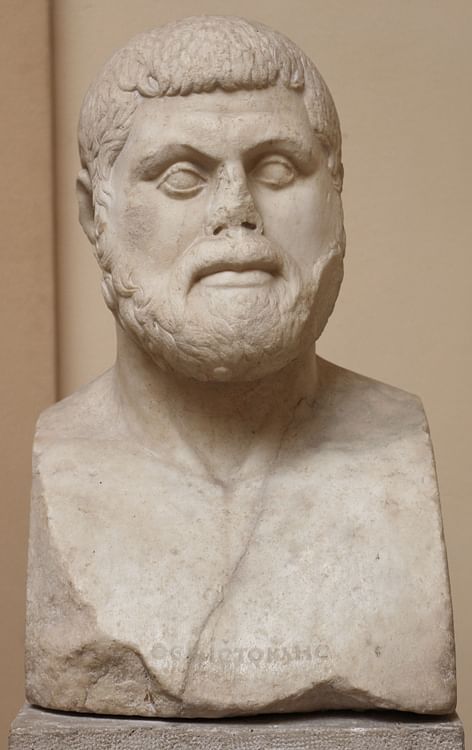
Themistocles (c. 524 - c. 460 BCE) was an Athenian statesman and general ( strategos ) whose emphasis on naval power and military skills were instrumental during the Persian wars, victory in which ensured that Greece survived its greatest ever threat. As the historian Thucydides stated in his History of the Peloponnesian War, 'Themistocles was a man who exhibited the most indubitable signs of genius; indeed, in this particular he has a claim on our admiration quite extraordinary and unparalleled.' (1.138.3). A brilliant strategist and canny politician he was perhaps a little too thirsty for glory and power for his own good but Themistocles was, without doubt, one of the most important and colourful figures of Classical Athens.
EARLY LIFE
Themistocles life is described by three notable ancient sources: Herodotus (c. 484 - c. 425 BCE), Thucydides (c. 460 - c. 399 BCE), and Plutarch (c. 45 CE - c. 120 CE). The first two are positive and praise the general's intelligence and quick wits while Plutarch presents a talented leader thirsty for power at any cost. Of his early life we know little except that, unusually for those who rose to the top echelons of power in Athens at the time, Themistocles did not come from an aristocratic family but a more humble middle-class one. In addition, we know that his mother was not an Athenian and his father was Neokles of the Lycomid family. According to Plutarch he was not a particularly gifted student and spent his free-time as a youth writing and performing speeches. His lack of qualifications is famously referenced in the following quote from the same writer,
Whenever in later life he found himself at any cultivated or elegant social gathering and was sneered at by men who regarded themselves as better educated, he could only defend himself rather arrogantly by saying that he had never learned how to tune a lyre or play a harp, but that he knew how to take a small or insignificant city in hand and raise it to glory and greatness. ( Themistocles, 78)
Plutarch also tells us he had two daughters called Sybaris and Italia and one son, whom Themistocles once described as the most powerful man in Greece:
He once said jokingly that his son, who was spoiled by his mother and through her by himself, was more powerful than any man in Greece, 'for the Athenians command the Greeks, I command the Athenians, his mother commands me, and he commands her.' ( Themistocles, 95)
THEMISTOCLES & ATHENIAN NAVAL POWER
Made archon in 493 BCE (although the significance of the title in this case is disputed by historians and may not refer to the typically understood highest administrative position) he is credited with developing Athens' port – the Piraeus – and building its fortifications and making it the largest naval base in the Greek world. As Thucydides puts it 'he [Themistocles] was always advising the Athenians, if a day should come when they were hard pressed by land, to go down into the Piraeus, and defy the world with their fleet' ( The History of the Peloponnesian War, 1.93.3).
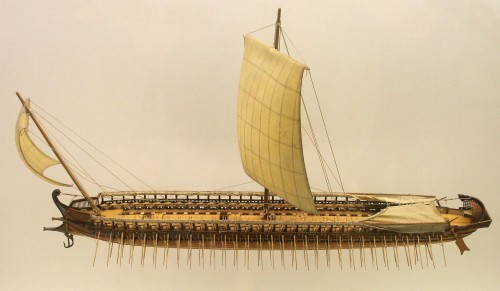
Greek Trireme
This was, then, the beginning of Athens becoming a significant and enduring naval power in the ancient Mediterranean. Still convinced that this was the way forward for the city, Themistocles, a decade later in 483 BCE, would use the excuse of an on-going conflict with Aegina to push for the surplus revenue from the silver mines of Laureion (discovered c. 503 BCE) to be used to build war ships expanding the Athenian fleet from 70 to 200 ships and so be ready too for a Persian invasion. In his focus on naval power Themistocles also claimed divine backing from the oracle of Apollo at sacred Delphi. He interpreted the typically obscure proclamation by the oracle that 'only a wooden wall will keep you safe' as meaning not fortification walls but wooden ships were Athens' best defence against invasion.
THE PERSIAN WARS
Persia invaded Greece in 490 BCE but the army of Darius was famously defeated at the battle of Marathon – a land battle of sword-wielding hoplites and archers. The beating of mighty Persia gave the Greeks magnificent confidence and the victory was celebrated as no other but, in the event, it was only a minor set-back to Persia's plans for invasion. For Darius' successor Xerxes would lead an even bigger army back on Greek soil in 480 BCE.
WITH THEMISTOCLES AT THE TOP OF THE POLITICAL TREE ATHENS SOUGHT TO STRENGTHEN HER NAVY AND ABANDON THE TRADITIONAL HOPLITE SOLDIER OF GREEK WARFARE.
In the period between these two attacks Themistocles secured political control of Athens, even managing to exile his great rivals Xanthippus in 484 BCE and Aristides in 482 BCE. With Themistocles at the top of the political tree Athens sought to strengthen her navy and practically abandon the traditional hoplite soldier of Greek warfare. Heavily armoured and carrying sword and huge shield, the slow hoplite was relocated to fast-moving warships – the trireme with its triple bank of oars.Meeting an enemy at sea, ramming the opposition and finishing the job with a small team of hoplites would be Themistocles' strategy to see off Greece's greatest ever threat.
THE BATTLE OF SALAMIS
In August 480 BCE the Persian army was met at the mountain pass of Thermopylae by a small band of Greeks led by Spartan King Leonidas. They held the pass for three days, and at the same time the Greeks, with the Athenian contingent led by Themistocles, managed to hold off the Persians at the indecisive naval battle at Artemision. Such was Themistocles' faith in his naval supremacy he ordered the abandonment of Athens (if a 3rd century BCE inscription known as the 'Themistocles Decree' from Troezen is to be believed). The combined Greek fleet, meanwhile, re-grouped in September at Salamis in the Saronic Gulf, west of Piraeus. The fleet included ships from some 30 city-states, notably from Corinth and Aegina, and made up a total of some 300 ships. Themistocles commanded the Athenian contingent, by far the largest in the fleet with perhaps 200 ships. The Persian fleet, although greatly exaggerated by ancient writers, was probably larger with around 500 ships.
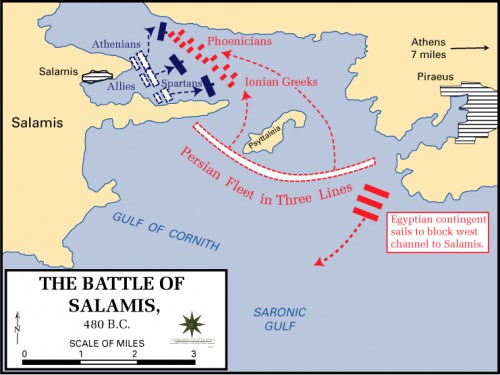
Battle of Salamis, 480 BCE
At this point some of the Greek states were in favour of abandoning Athens and a naval conflict; instead their proposal was to fortify the Isthmus of Corinth. Themistocles then may have sent word to the Persians of this possibility. He also had the Ionians and Carians in Xerxes' army spread messages to the effect that their loyalty was not to be trusted in the event of battle. These mixed messages and possible indicators of fractions in the Greek coalition galvanized the Persians into action so that they moved at night and blocked the straits, preventing the Greek fleet from abandoning their position. The wily Themistocles urged the wavering Greeks to action, retorting to one commander: 'those left behind at the starting line are never crowned with the victor's wreath' ( Histories, 8.59). He would have his naval engagement and have it exactly where he wanted - Salamis.
When daylight came the battle commenced. The Greeks held back and drew the bigger Persian fleet into the narrow straits. In addition, Themistocles knew that at a certain time of day a breeze and heavy swell would come and the Persians would be unprepared for this. In the confusion, the Persians had no maneuverability, their space was further limited by more of their ships coming in from their rear, and their sailors had no shore to retreat to after their vessel was sunk, unlike the Greeks.Picking off the Persian ships one at a time and spurred on by the knowledge they were fighting for their lives and their way-of-life, the Greeks were victorious. Themistocles was treated as a hero and even given honours by Athens' great rival city Sparta.
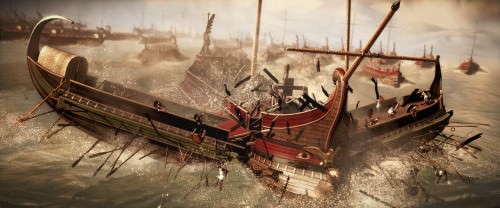
Trireme Ramming
FINAL VICTORY
Xerxes went back home to Susa but the Persian land army, now commanded by Mardonius, was still a significant threat and so the two sides clashed again, this time on land at Plataea in August 479 BCE. These forces were commanded by Xanthippus and Aristides, back from exile, and there is no mention of Themistocles. Once again though, the Greeks, fielding the largest hoplite army ever seen, won the battle which finally ended Persia's ambitions in Greece.
THEMISTOCLES REBUILDS ATHENS
The Persian wars won a freedom which would allow Greece a never-before-seen period of artistic and cultural endeavour which would form the foundations of Western culture for millennia. More immediately, Themistocles re-fortified Athens and the Piraeus, and he also established the Kerameikos cemetery. To ensure Greece could resist any future attacks the Delian League was formed in 477 BCE. This was a federation of Greek city-states led by, and later to be entirely dominated by, Athens with each member contributing ships and money.

Ostraka for Themistocles
EXILE & DEATH
Athens was never in such a strong position but the career of Themistocles was, unfortunately, heading for a nose-dive. He was, following accusations of bribery, sacrilege, and a suspicious association with Spartan traitor Pausanias exiled from the city from 476 to 471 BCE. Themistocles' shadow remained, at least in the arts, as it was in 472 BCE that the great playwright Aeschylus produced his Persians which described the aftermath of Themistocles' and Athens' great victory at Salamis.
Rather ironically, and after a brief stay in Argos and then Corcyra ( Corfu ), Themistocles fled from Greece by merchant vessel and was welcomed in Persia by Artaxerxes I. He was made governor of Magnesia in Ionia where coins were minted bearing his name. Understandably, the Athenians saw this as treason and officially declared Themistocles a traitor, condemned him to death, and confiscated all his property. It was not to be a happy move for Themistocles as he died in Magnesia not long afterwards, with rumours suggesting he may have been poisoned or that he even committed suicide. More probably dying of illness, Thucydides claimed his bones were secretly returned to Athens but the fact that his son continued his reign in Magnesia and a tomb was built for the great Athenian would suggest this is unlikely.
Salamis › Antique Origins
Definition and Origins
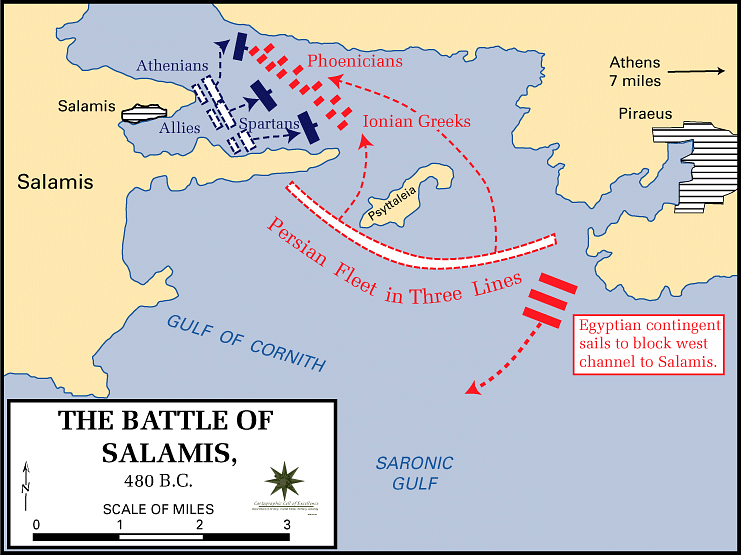
With defeat at Thermopylae, the inconclusive naval battle at Artemision, and Xerxes ' Persian army on the rampage, the Greek city -states faced an unprecedented attack, one which threatened their very existence. The tide would turn, though, in September 480 BCE at the Battle of Salamis in the Saronic Gulf, a naval battle which would rank as one of the greatest and most significant in antiquity. Overcoming superior numbers with daring tactics and sheer determination, the allied Greek forces won a freedom which would allow a never-before-seen period of artistic and cultural endeavour which would form the foundations of Western culture for millennia.
CONTEXT: THE PERSIAN WARS
By the first years of the 5th century BCE, Persia, under the rule of Darius (r. 522-486 BCE), was already expanding into mainland Europe and had subjugated Thrace and Macedonia. The next objective was to quell once and for all the collection of potentially troublesome rebel states on the western border of the Empire. In 490 BCE Greek forces led by Athens met the Persians in battle at Marathon and defeated the invaders. The battle would take on mythical status amongst the Greeks, but in reality it was merely the opening overture of a long war with several other battles making up the principal acts. In 486 BCE Xerxes became king, and he invaded first the Cyclades and then the Greek mainland after victory at Thermopylae in August 480 BCE against a token Greek force. At the indecisive naval battle of Artemision (also in August 480 BCE), the Greeks held off the superior numbers of the Persian fleet but were obliged to regroup at Salamis.
Greece then, lay open to the invaders and Persian forces rampaged through the Greek poleis or city-states, sacking even Athens itself. Some 30 Greek poleis, however, were preparing to fight back and the Battle of Salamis would show Xerxes that Greece, or at least a large chunk of it, was far from being conquered.
THE PERSIAN FLEET
The vast Persian Empire stretched from the Danube to Egypt and from Ionia to Bactria, and Xerxes was able to draw on a huge reserve of resources to amass a huge invasion force. Ariabignes, the son of Darius, commanded the Ionian, Carian, Achaimene, and Egyptian fleets. Cybernis, the king of Xanthos, led the Lycian fleet of 50 ships. Artemisia, the tyrant of Halicarnassus, led the Dorian fleet of 30 ships and other known commanders included Prexaspes, Megabazus, and Achaimenes. Technically, the Persians, and especially the Phoenicians, were better seamen, but as the fleet was drawn from all parts of the Empire, the motivation and communication levels were perhaps less than their opponents who all spoke the same language and who were fighting not only for their own survival but that of their families and their way of life.
THE PERSIAN FLEET SIGNIFICANTLY OUTNUMBERED THE GREEKS.
The exact number of ships in the Persian fleet is not known. Herodotus in his Histories (440-430 BCE) compiles precise lists but these are widely thought to be exaggerated and unreliable. Also, his list is for the Persian fleet which originally sailed to Greek waters and by the time of Salamis, many would have been left to guard ports and supply routes or have been lost in storms (especially at Magnesia) and in the Battle of Artemision a month earlier. Nevertheless, below are his figures for triremes - warships with three banks of oars (note the contributions from conquered or pro-Persian Greek cities ):
- Phoenician 300
- Egyptian 200
- Cyprian 150
- Cilician 100
- Ionian 100
- Hellespontine 100
- Carian 70
- Aolian 60
- Lycian 50
- Pamphylian 30
- Dorian 30
- Cyclades 17
An alternative source - the writer of Greek tragedy Aeschylus - does seem to support Herodotus in his Persae (472 BCE) where he states that the Persian fleet had 1,207 ships compared to the Greek force of only 310. Accounting for losses incurred in the manner described above it is estimated that perhaps around 500 triremes faced the Greeks at Salamis but there is no scholarly consensus on even an approximate figure. There would also have been many smaller ships such as penteconters (50 oars) and triaconters (30 oars) but Herodotus' figure of 3000 seems wildly exaggerated.

Greek Trireme
THE GREEK FLEET
The allied Greek fleet was commanded by the Spartan Eurybiades, a surprising choice considering it was Athens who was the great naval power and supplied by far the most ships. The two other senior commanders were Themistocles of Athens and Adeimantus of Corinth. In effect, tactics and strategy were decided by a council of 17 commanders from each of the contributing contingents. However, it is Themistocles, the brilliant naval commander, drawing on his twenty-year experience and flush from the success of Artemision against far superior numbers, who is widely credited with deciding to hold position at Salamis instead of retreating to the isthmus of Corinth and masterminding the Greek victory.
Herodotus' figures are once again inconsistent, his grand total of 380 triremes making up the Greek fleet is 15 more than the sum of his individual state contributions:
- Athens 200
- Corinth 40
- Aegina 30
- Megara 20
- Sparta 16
- Sicyon 15
- Epidaurus 10
- Eretria 7
- Ambracia 7
- Troezen 5
- Naxos 4
- Hermione 3
- Leucas 3
- Styra 2
- Ceos 2
- Cythnos 1
The figures for some states are suspiciously similar to those given before the Battle of Artemision, implausibly suggesting either they suffered next to no losses in that conflict or a swift replacement of vessels. Aeschylus states a total figure of 310 and Thucydides 400. In summary, we can only say that the Persian fleet seems to have significantly outnumbered the Greek.
THE TRIREME
Both sides had very similar ships - the triremes ( triērēis ) - which were 40-50 ton wooden warships up to 40 m long. Light, streamlined, and manoeuvrable, they were powered in battle by 170 oarsmen split in three ranks down each side of the ship.Able to rapidly accelerate, break, zigzag, and turn 360 degrees in just two ships' lengths, good seamanship could place the vessel to best advantage and employ the principal strategy of naval warfare at that time which was to ram the enemy, making full use of the bronze ram fitted to the prow of the vessel. Triremes also carried a small complement of soldiers, at least 10 hoplites and four archers. The Persians generally carried more - 14 combatants and 30 Medes armed with bow, spear, and sword. These extra troops came into their own when at close quarters with the enemy and in the case of boarding an enemy vessel.
Triremes had a weakness in that they could only operate effectively in relatively calm seas with waves less than 1 m high;otherwise, water would enter via the oar-ports and flood the ship. Also, they had to stay close to shore as each night they needed to be beached if the light wood was not to become water-logged, significantly reducing the speed performance of the vessel. In addition, there was very little space on board for provisions and no room to sleep so the crews had no choice but to land each night. Prior to the battle the Greek ships were beached at several bays on the island of Salamis from Cynosoura to Paloukia. Here too were much of the evacuated populace of Athens and Attica. The Persians, meanwhile, were stationed at the Phaleron Bay, less than 10 km away across the Saronic Gulf and close to the captured Piraeus.

Trireme Ramming
STRATEGIES
Commanders led from the front and each would have been on his own ship at the heart of the battle. From there, manoeuvres could be signalled to other ships in the fleet using flags and trumpets. However, once the battle got fully underway, naval conflicts became a case of a single ship against a single opponent rather than precisely coordinated manoeuvres.
Prior to full engagement between the opposing fleets, there were two principal strategies employed by the more able commanders. The first was sailing around the enemy line ( periplous ) and the second was smashing through gaps in the enemy line and attacking from their rear flank ( diekplous ). Both were designed to get one's ship in a position to ram the weakest point of the enemy - the side or stern quarter. The objective was to puncture a hole in the enemy vessel or break a sufficient number of their oars to disable the ship. To avoid damaging one's own oars, crews were drilled to withdraw them in a matter of seconds (usually on only one side of the ship whilst the other side maintained the momentum of the vessel). As a defence against these two tactics, an able commander would ensure one of his flanks was closed off by shallows or coastline and ensure his crews were sufficiently drilled to maintain close order. In open water the ships could be organised in a defensive circle or an arc (more practical with larger fleets) with prows pointing outwards ( kyklos ).
THE BATTLE
The actual details of the battle are sketchy and often contradictory between ancient sources. Nevertheless, presenting the most commonly agreed upon elements, the first action of the battle was the defection of two Ionian ships to the allied Greek fleet. Themistocles, perhaps sending messages to the pro-Persian Greek state fleets, had hoped for more such defections but no others occurred. One such ship from Tenos informed the Greeks that the Persians were amassing in the straits, blocking in the Greek fleet. The Persians had moved into position overnight, hoping to surprise the enemy, but this strategy was unlikely to be successful considering the short distances involved and the noise made by the rowers. There is also the possibility that Themistocles had sent messages to Xerxes intimating the fragile Greek alliance was breaking up and the fleet was about to retreat.
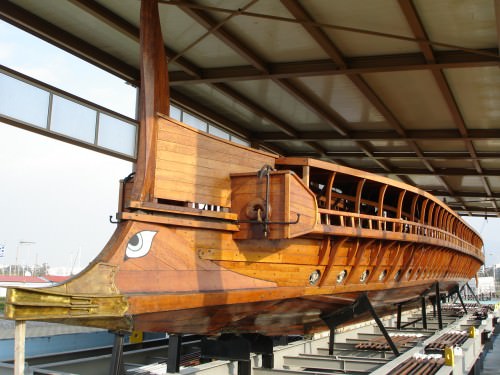
Trireme Hull with Bronze Ram
Probably, the two fleets aligned along an oblique east-west axis with the Persians close to the mainland shore with both fleets having a friendly shore behind them. Indeed, proximity to the opposite mainland shore would have been avoided by the Greek ships due to Xerxes' positioning there of a contingent of his archers. On the western (right) wing the Phoenicians faced the Athenians and the Ionians against the Spartans. On the left flank of the Persians were the Carians and Dorians. Behind the main Greek line, the Aegina contingent and some of the Athenian ships waited in reserve. The Corinthians were stationed to the west of the battle lines protecting the passage to Eleusis whilst the pro-Persian Cyprians, Cilicians, and Hellespontines held back to the south, guarding the exit to Piraeus. According to Diodorus Siculus, Xerxes sent his Egyptian fleet to seal off the straits between Salamis and Megara and engage any Greek ships breaking off from the main fleet.
Overlooking from his command post in the early morning, Xerxes would have seen not a fleet about to retreat but the Greeks positioned two-ships deep along a 3 km long curve, perhaps presenting a line of 130 ships against the Persian main front of 150 ships, three ships deep. The Persians advanced, becoming more closely packed as they aligned themselves with the enemy's narrower front. The Greeks held position, drawing the Persians into an ever tighter confine. Ships began to ram each other and in the tight space they would have struggled to disengage. Then the armed soldiers on board would have come into their own with hoplites and archers fighting on the decks much as in a land battle. With more Persian ships pressing in from the rear and the Corinthians joining from the side, there must have been a chaos of broken ships and drowning men - particularly amongst the Persians who had no shore to retreat to and most probably could not swim.
With more space to manoeuvre, the Greek ships were able to pick off the closely packed Persian vessels which could not retreat because their lines were now several ships deep. By the afternoon, Greek victory was assured and the remaining Persian ships retreated to Asia Minor. The final stage of the battle was the transferral of the Greek hoplite force on Salamis over to the mainland which then made short work of the Persian land forces.
Once again the cryptic oracle of Apollo at Delphi had been proved right: 'only a wooden wall will keep you safe'. As at Artemision, the wooden ships of the combined Greek fleet had, for a second time, rebuffed the Persian advance.
THE AFTERMATH
Following defeat, Xerxes returned home to his palace at Sousa and left the gifted general Mardonius in charge of the invasion.The Persian position was still strong despite the defeat - they still controlled much of Greece and their large land army was intact. After a series of political negotiations, it became clear that the Persians would not gain victory on land through diplomacy and the two opposing armies met at Plataea in August 479 BCE. The Greeks, fielding the largest hoplite army ever seen, won the battle and finally ended Xerxes' ambitions in Greece.
LICENSE:
Article based on information obtained from these sources:with permission from the Website Ancient History Encyclopedia
Content is available under License Creative Commons: Attribution-NonCommercial-ShareAlike 3.0 Unported. CC-BY-NC-SA License